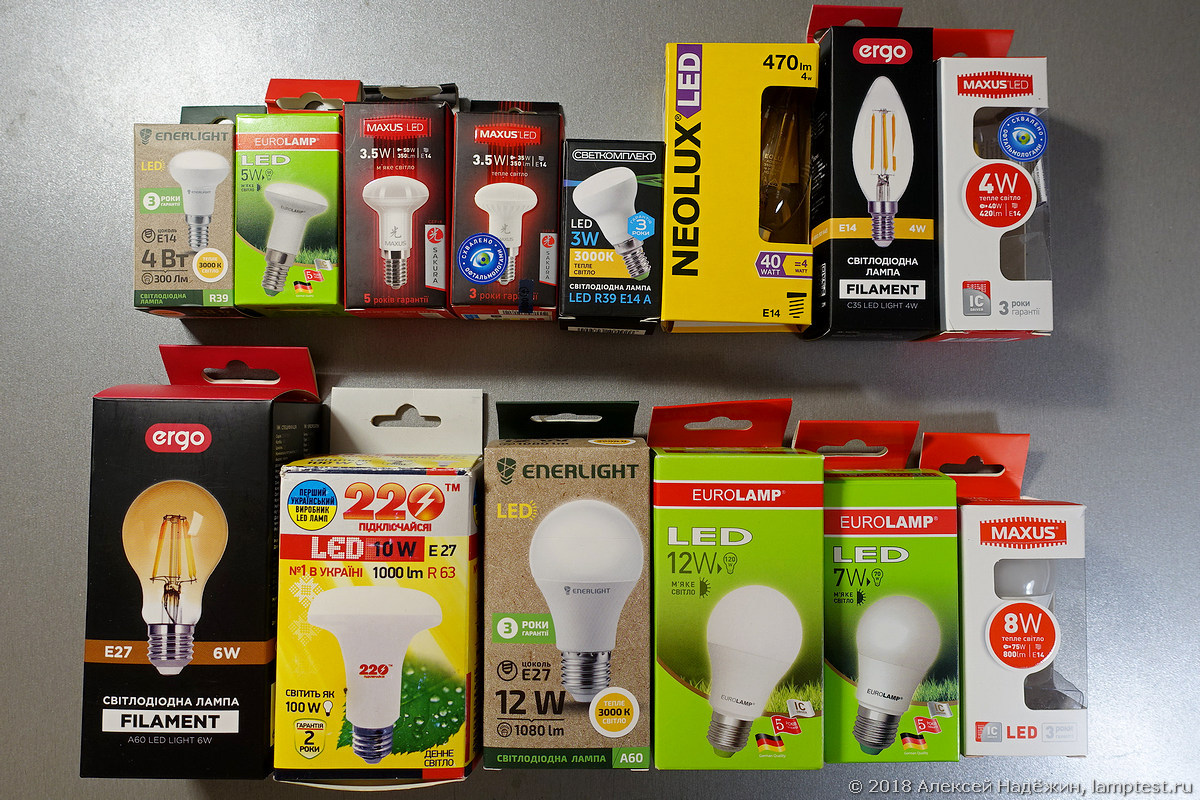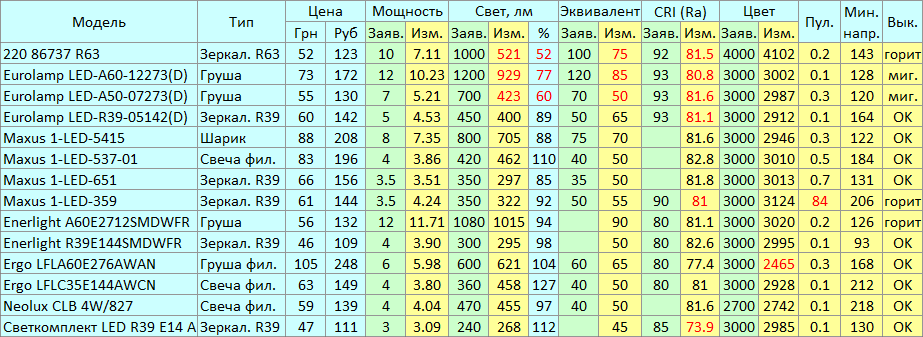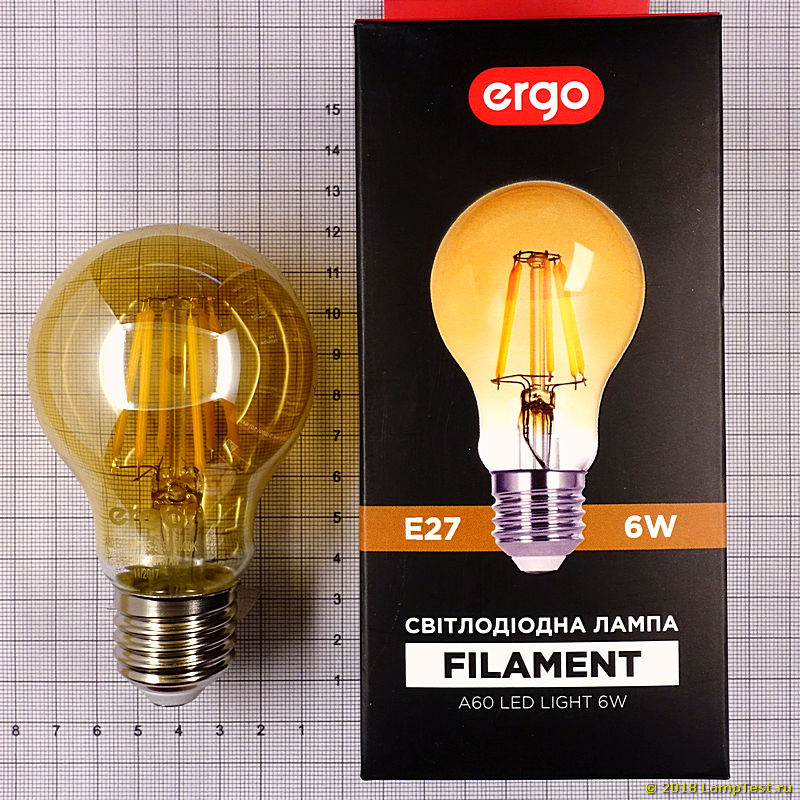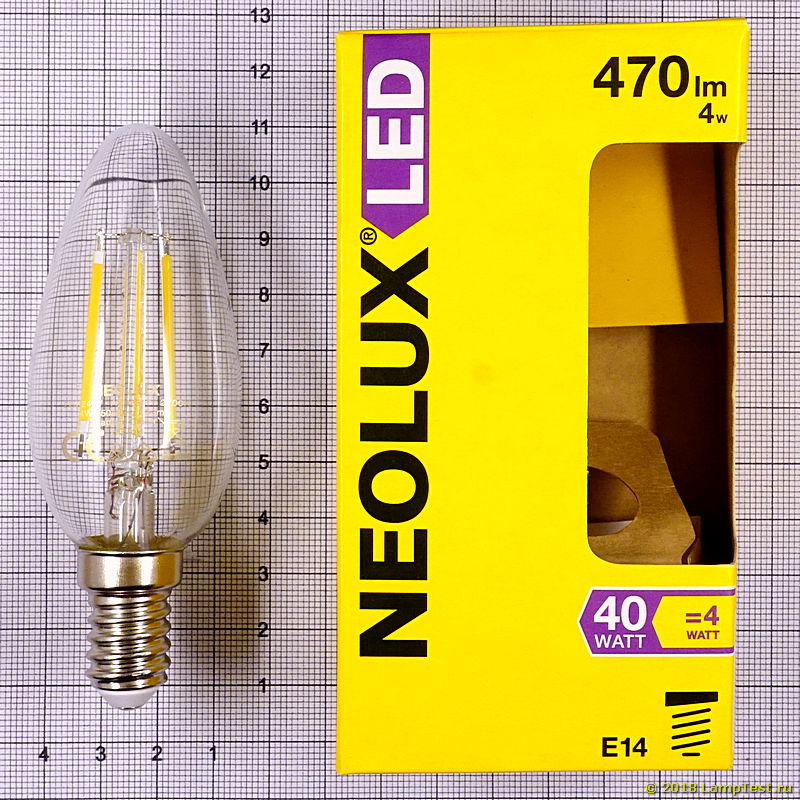LED lamps with / from Ukraine
International brands that produce LED lamps can be counted on the fingers of one hand, but in each country there are many local brands. Most of the lamps that I tested on Lamptest.ru are sold only in Russia, but the site is also used in other countries. Mikhail Rybintsev was able to smuggle 14 lamps of seven Ukrainian brands from Kiev.

Ukrainian manufacturers indicate excellent parameters on their LED lamps: the lamp “220” has a CRI Ra> 92 color rendering index, Eurolamp Ra> 93, Maxus Ra> 90, Svetokomplekt Ra> 85. Is it true? Looking ahead, I will say that no. Ukrainian consumers are being cheated in the same way as Russian ones.
I measured the parameters of the lamps using accurate laboratory equipment.
The luminous flux, color temperature and color rendering index were measured using a two-meter integrating sphere and a Instrument Systems CAS 140 CT spectrometer , the power consumption of a GW Instek GPM-8212 instrument, a pulsation level with a Uprtek MK350D instrument . The minimum operating voltage was measured using a Lamptest-1 device , a stabilizerCalm Instab 500 and Latte Suntek TDGC2-0.5. Before measurements to stabilize the parameters of the lamp warmed for half an hour.

None of the tested lamps have the promised high color rendering indices. The lamp “220” instead of 92 is only 81.5, all three Eurolamp instead of 93 have about 81, Svetomkomplet has 85 instead of 85. Three of the four Maxus lamps have no color rendering index, one has 90, in fact, all four have 81 -82.
The lamp “220”, with the motto “№1 in Ukraine”, almost doubled the luminous flux: 1000 lm is indicated, and in fact only 521 lm. In the case of two Eurolamp pear lamps, the actual luminous flux is also significantly lower than the indicated one: 1200 and 700 lm are written on the boxes, and in fact, 929 and 423 lm.
All but one lamp have no pulsation (ripple less than 1%). The lamp Maxus 1-LED-359 R39 found an unacceptable and very noticeable ripple of 84%.
The Ergo LFLA60E276AWAN filament lamp has a color temperature of 3000K, but the glass of this lamp is tinted and the light is even visually yellow. According to the measurement results, the color temperature was 2465K.

Nine of the fourteen tested lamps work correctly with a switch having an indicator (“OK” in the column off), three lamps are faint when the switch is turned off (“on” in the table), two flashes when the switch with the indicator is off (“instant” in table).
Most lamps are equipped with a stabilizing IC driver and can operate with a significant reduction in the supply voltage without changing the brightness. In the filament “candles” and the R39 Maxus 1-LED-359 light bulb linear drivers are used, so their brightness directly depends on the supply voltage and even with a slight decrease, the brightness drops. The minimum voltage at which the brightness of the lamp is at least 95% of the maximum is indicated in the column “Min. for example.
The test was attended by many "mirror" lamps R39 and one R63. These bulbs differ in terms of equivalent calculation, since the corresponding incandescent bulbs give far less light than pears or candles. That is why for many lamps of this type the measured equivalent in the table is larger than the stated one (many manufacturers do not know that for “DSLRs” the equivalent needs to be specified differently).
The Neolux lamp, the measured parameters of which exactly correspond to those stated, was produced by Ledvance, the main brand of which is OSRAM and in fact is no different from the similar OSRAM lamp.

If we turn a blind eye to deception with the parameters, 12 of the 14 tested lamps are quite normal - they have no ripple, the CRI (Ra) color rendering index is more than 80, which means they can be used in residential premises. It is only important to understand that what is written on the lamp box may not be true and take into account the real parameters of these lamps.
In general, the situation on the market for LED lamps in Ukraine is exactly the same as in Russia - many manufacturers overestimate the parameters of lamps, taking advantage of the fact that without special expensive equipment it is impossible to expose fraud. I am glad that only two of the fourteen tested lamps were completely bad.
© 2018, Alexey Nadyozhin

Ukrainian manufacturers indicate excellent parameters on their LED lamps: the lamp “220” has a CRI Ra> 92 color rendering index, Eurolamp Ra> 93, Maxus Ra> 90, Svetokomplekt Ra> 85. Is it true? Looking ahead, I will say that no. Ukrainian consumers are being cheated in the same way as Russian ones.
I measured the parameters of the lamps using accurate laboratory equipment.
The luminous flux, color temperature and color rendering index were measured using a two-meter integrating sphere and a Instrument Systems CAS 140 CT spectrometer , the power consumption of a GW Instek GPM-8212 instrument, a pulsation level with a Uprtek MK350D instrument . The minimum operating voltage was measured using a Lamptest-1 device , a stabilizerCalm Instab 500 and Latte Suntek TDGC2-0.5. Before measurements to stabilize the parameters of the lamp warmed for half an hour.

None of the tested lamps have the promised high color rendering indices. The lamp “220” instead of 92 is only 81.5, all three Eurolamp instead of 93 have about 81, Svetomkomplet has 85 instead of 85. Three of the four Maxus lamps have no color rendering index, one has 90, in fact, all four have 81 -82.
The lamp “220”, with the motto “№1 in Ukraine”, almost doubled the luminous flux: 1000 lm is indicated, and in fact only 521 lm. In the case of two Eurolamp pear lamps, the actual luminous flux is also significantly lower than the indicated one: 1200 and 700 lm are written on the boxes, and in fact, 929 and 423 lm.
All but one lamp have no pulsation (ripple less than 1%). The lamp Maxus 1-LED-359 R39 found an unacceptable and very noticeable ripple of 84%.
The Ergo LFLA60E276AWAN filament lamp has a color temperature of 3000K, but the glass of this lamp is tinted and the light is even visually yellow. According to the measurement results, the color temperature was 2465K.

Nine of the fourteen tested lamps work correctly with a switch having an indicator (“OK” in the column off), three lamps are faint when the switch is turned off (“on” in the table), two flashes when the switch with the indicator is off (“instant” in table).
Most lamps are equipped with a stabilizing IC driver and can operate with a significant reduction in the supply voltage without changing the brightness. In the filament “candles” and the R39 Maxus 1-LED-359 light bulb linear drivers are used, so their brightness directly depends on the supply voltage and even with a slight decrease, the brightness drops. The minimum voltage at which the brightness of the lamp is at least 95% of the maximum is indicated in the column “Min. for example.
The test was attended by many "mirror" lamps R39 and one R63. These bulbs differ in terms of equivalent calculation, since the corresponding incandescent bulbs give far less light than pears or candles. That is why for many lamps of this type the measured equivalent in the table is larger than the stated one (many manufacturers do not know that for “DSLRs” the equivalent needs to be specified differently).
The Neolux lamp, the measured parameters of which exactly correspond to those stated, was produced by Ledvance, the main brand of which is OSRAM and in fact is no different from the similar OSRAM lamp.

If we turn a blind eye to deception with the parameters, 12 of the 14 tested lamps are quite normal - they have no ripple, the CRI (Ra) color rendering index is more than 80, which means they can be used in residential premises. It is only important to understand that what is written on the lamp box may not be true and take into account the real parameters of these lamps.
In general, the situation on the market for LED lamps in Ukraine is exactly the same as in Russia - many manufacturers overestimate the parameters of lamps, taking advantage of the fact that without special expensive equipment it is impossible to expose fraud. I am glad that only two of the fourteen tested lamps were completely bad.
© 2018, Alexey Nadyozhin
